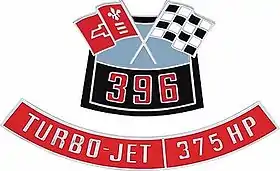 L78 air-cleaner decal | |
| Layout | |
| Configuration | Naturally aspirated 90° V8 |
| Displacement | 396–402 cu in (6.5–6.6 L) |
| Cylinder bore | 4.094 in (104.0 mm) 4.126 in (104.8 mm) |
| Piston stroke | 3.76 in (95.5 mm) |
| Cylinder block material | Cast iron |
| Cylinder head material | Cast iron, Aluminum |
| Valvetrain | OHV 2 valves x cyl. |
| Combustion | |
| Fuel system | Carburetor |
| Fuel type | Gasoline |
| Cooling system | Water-cooled |
| Output | |
| Power output | 375–425 hp (280–317 kW) |
The L78 was a Big-Block engine produced by Chevrolet between 1965 and 1970. Rated at 425 hp (317 kW) for its first year, the rating dropped to 375 hp (280 kW) in subsequent years (although there was no change in power). Between 1966 and 1969 it was the most powerful Regular Production Option engine available in Chevrolet's intermediate line, making it a highly-collectible muscle car engine today.
History
The second-generation Chevrolet Big-Block engine was introduced at the 1963 Daytona 500 as the Mark II. The block entered production in mid 1965 as the Mark IV 396 cu in (6.5 L) "Turbo-Jet," phasing out the first-generation W-series Big-Block. In its first year the 396 was available as the L78 option in Corvettes and full-sized (Impala, Bel Air, Biscayne) models, and as the L37 in the intermediate (Chevelle) model. These engines differed only in that the L78 had a solid-lifter camshaft, while the L37 had a hydraulic lifter cam shaft.
In 1966 the L78 was available exclusively in the intermediate line. For 1967 the engine was additionally available in Chevrolet's new pony car, the Camaro. The following year the motor became available in the compact Chevy II also.
For the 1970 model year the 396 was bored 0.03 in (0.76 mm), resulting in a 402 cu in (6.6 L) engine. Despite this, the motor was still badged as a 396. 1970 was also the final production year for the L78. Although 1970 LS6 Chevelles are generally more collectible today, 1970 L78 Chevelles are in fact rarer (4,475 units versus 2,144).
Between 1966 and 1969 the L78 was the highest-horsepower engine available in Chevrolet's intermediate line via a Regular Production Option (RPO). Despite this, in 1969 an L72 427 cu in (7.0 L), 425 hp (317 kW) engine could be ordered in an intermediate via a Central Office Production Order (COPO). This option bypassed a rule that existed prior to 1970 wherein intermediate models were restricted to engines with displacements less than 400 cu in (6.6 L). Only 323 of these cars were produced. With the lifting of the restriction in 1970 and the introduction of the 454, the COPO option in Chevelles was discontinued.
L89
A version of the L78 was also produced with aluminum cylinder heads and sold as RPO L89. This option did not change performance, but reduced engine weight by roughly 75 lb (34 kg). This engine was available from 1968 to 1970.
Production numbers
L78
| Full (Impala, Bel Air, Biscayne) | Intermediate (Chevelle, El Camino) | Compact (Chevy II, Nova) | Pony (Camaro) | Sports (Corvette) | |
| 1965 | 1,838 | 2,157 | |||
| 1966 | 3,099 | ||||
| 1967 | 612 | 1,138* | |||
| 1968 | 4,751 | 667 | 4,575** | ||
| 1969 | 9,486 | 3551 | 4,889 | ||
| 1970 | 2,144 | 1715 | 600 |
- * 54 of these were converted into L72 Yenko Super Camaros.
- ** 64 of these were converted into L72 Yenko Super Camaros.
L78/L89
| Intermediate (Chevelle, El Camino) | Compact (Chevy II, Nova) | Pony (Camaro) | |
| 1968 | 272 | ||
| 1969 | 400 | 311 | |
| 1970 | 18 |
References
- DeMauro, Thomas A. "Simultaneous Combustion - 1967 Chevrolet Chevelle SS L78: How a 1967 Chevelle SS L78 396/375-hp tribute project led to restoring a numbers-matching original--at the same time." In Hemmings Muscle Machines. August 2014.
- Niedermeyer, Paul. "1965 Chevelle SS396 Z16: 201 Built, And A Common 396 Engine Misunderstanding Finally Resolved." In Cubside Classic Online. http://www.curbsideclassic.com/blog/1965-chevelle-ss396-z16-201-built-and-a-common-396-engine-misunderstanding-resolved/.
- Zazarine, Paul. "1969 L78 SS396 Chevelle - The Factory's Fastest." In Super Chevy Online. http://www.superchevy.com/features/sucs-0732-1969-chevelle-l78/.